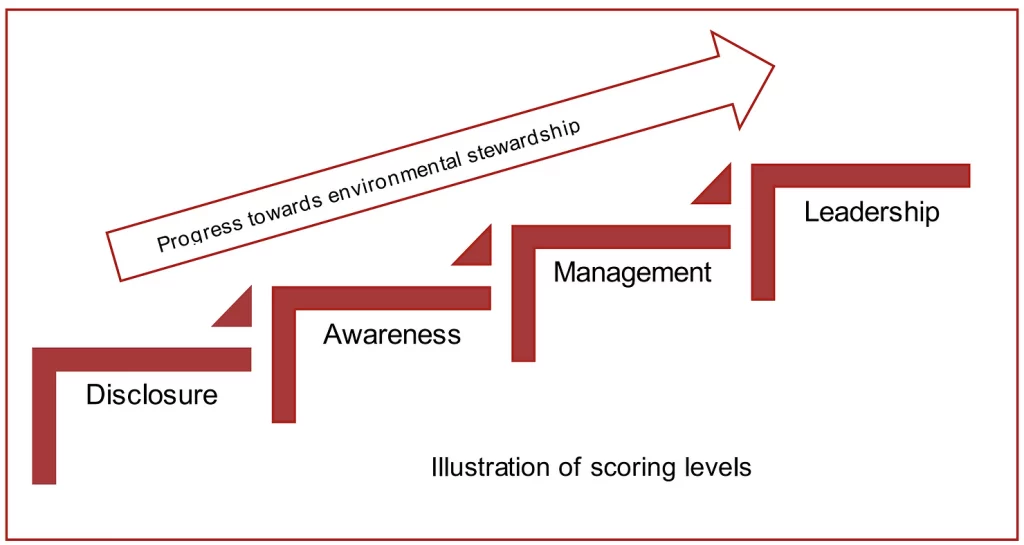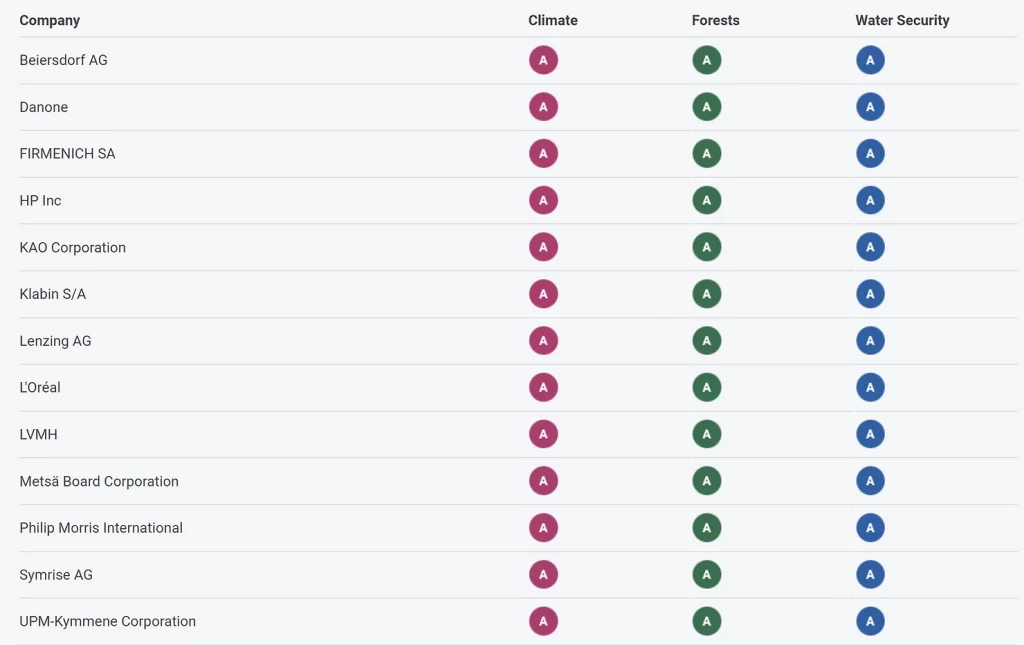History Overview
The CDP, formerly known as the Carbon Disclosure Project, has a rich history as an international non-profit organization. With its roots in the United Kingdom, it has expanded its reach to Japan, India, China, Germany, Brazil, and the United States. CDP’s mission is to normalize environmental reporting and risk management across the business world.
It initially embraced GRI’s environmental disclosure concept in 2002, focusing on individual corporations rather than nations. Starting with just 35 investors and 245 responding companies, CDP has grown to score nearly 15,000 companies in 2023, becoming the custodian of the world’s most extensive environmental database.
This ESG framework uses a questionnaire covering climate change, deforestation, and water usage, which then calculates a sustainability score and provides feedback on potential ESG risks and opportunities.

Methodology
CDP’s scoring, a reflection of a company’s environmental commitment, ranges from D- (beginning of the journey) to A (leadership in environmental stewardship). This system is designed to encourage a transparent assessment of environmental impact, guiding companies toward a sustainable, deforestation-free, and water-secure future. The scoring methodology is intricate, assessing the depth of response, awareness of environmental issues, and the effectiveness of management methods.
Disclosure (D-/D score)
Every question in the questionnaires is scored for disclosure. At the disclosure level, companies are awarded roughly one point per data point provided. This level features both D and D- score. To score a D over a D- organizations need to have disclosed a more extensive set of information. However, a D-/D score is just the starting point for organizations that want to demonstrate that they have begun their environmental journey.
Awareness (C-/C score)
A C-/C score indicates awareness-level engagement. Awareness also has C and C- scores, with the differentiator being the level of awareness a company has shown in their response. The awareness score measures the comprehensiveness of a company’s evaluation of how environmental issues intersect with its business, and how its operations affect people and ecosystems.
Management (B-/B score)
A B score indicates environmental management. Companies that score a B have addressed the environmental impacts of their business and ensure good environmental management. A B-score indicates that a company is showing some evidence of managing its environmental impact but is not undertaking actions that mark it out as a leader in its field.
Leadership (A score)
To earn an A score from CDP, organizations must show environmental leadership, disclosing action on climate change, deforestation or water security. They must demonstrate best practice in strategy and action as recognized by frameworks such as the TCFD, Accountability Framework and others. As well as having high scores in all other levels these companies will have undertaken actions such as setting science-based targets, creating a climate transition plan, developing water-related risk assessment strategies, or reporting on deforestation impact for all relevant operations, supply chains and commodities.
There are 15 modules in the general climate change questionnaire, including the Introduction and Signoff modules, plus a module presented only to organizations that are responding to a customer request from one or more CDP Supply Chain Members. The journey through CDP’s general climate change questionnaire includes the following:
- Governance
- Risks and opportunities
- Business strategy
- Targets and performance
- Emissions methodology
- Emissions data
- Energy
- Additional metrics
- Verification
- Carbon pricing
- Engagement
- Biodiversity
Score weighting and calculations
The CDP Scoring Methodology for 2023 involves a structured and detailed approach to assess a company’s environmental impact and actions. Here are the key details:
- Scoring Levels: The methodology includes four levels of scoring.
- Disclosure: This level evaluates the completeness of the information provided by a company. It is the foundational step where companies report on their environmental data and activities.
- Awareness: At this level, the focus is on how well a company understands its environmental impact. It assesses the company’s knowledge about how environmental issues intersect with its business operations.
- Management: This stage evaluates the strategies and policies a company has in place to manage its environmental impact. It looks at the effectiveness and implementation of these management strategies.
- Leadership: The highest level, Leadership, assesses the extent to which a company is leading the way in environmental stewardship. It involves scrutinizing the actions taken by the company to mitigate its environmental impact and innovate in this area.
- Sector-Specific Questions: The scoring system includes sector-specific questions for certain industries. This ensures that companies in sectors with significant environmental impacts are assessed with relevant and specific criteria.
- Point Allocation: Each question in the questionnaire has a specific point allocation. This system provides clear criteria for how companies can achieve points at each scoring level.

Advantages
- Investor Transparency: The CDP framework allows companies to be transparent with a large group of investors. This transparency is increasingly valued by the investment community as they consider climate change a significant risk to their portfolios. Companies that transparently report their climate risks are seen as less risky investments.
- Risk Identification: The CDP’s questionnaires prompt companies to identify risks associated with climate change, water scarcity, and deforestation. This process helps companies to prepare for potential losses related to environmental issues and make informed decisions to mitigate these risks.
- Benchmarking and Verification: Reporting to the CDP enables companies to benchmark their data against competitors. This helps in setting baselines and working towards sustainability goals. Additionally, CDP encourages independent verification of reports, which can help companies improve their data accuracy and identify areas for improvement. This verification process can also enhance a company’s CDP score.
Disadvantages
- Resource Intensive: The process of collecting, analyzing, and reporting the required information can be time-consuming and resource-intensive for companies. This might be particularly challenging for smaller businesses with limited resources.
- Limited Scope: While the CDP framework covers important areas like climate change, water security, and deforestation, it might not encompass all aspects of environmental impact. This could lead to a narrow focus on certain areas while potentially overlooking others.
- Voluntary Participation: As the CDP is a voluntary framework, it might not have the same level of enforcement or accountability as mandatory reporting standards. This could limit its effectiveness in driving change among all companies.
References
- CDP. (n.d.). CDP Scores Explained. Available at: https://www.cdp.net/en/scores/cdp-scores-explained.
- Wikipedia contributors. (n.d.). Carbon Disclosure Project. Wikipedia. Available at: https://en.wikipedia.org/wiki/Carbon_Disclosure_Project.
- CDP. (n.d.). Guidance. Available at: https://guidance.cdp.net/en/guidance?cid=30&ctype=theme&idtype=ThemeID&incchild=1µsite=0&otype=Questionnaire&tags=TAG-13071%2CTAG-605%2CTAG-600.
- Quantive. (n.d.). ESG Frameworks. Available at: https://quantive.com/resources/articles/esg-frameworks.







